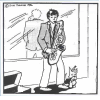Sunday, December 31, 2006
Happy Feet review
 This morning, J, L and I went to see Happy Feet. While this singing/dancing penguin spectacular has bemused some critics, it's generally been well received - David Stratton on The Movie Show even gave it 5 stars. Well, any film that begins and ends with music from Abbey Road is probably well on the way to winning me over :).
This morning, J, L and I went to see Happy Feet. While this singing/dancing penguin spectacular has bemused some critics, it's generally been well received - David Stratton on The Movie Show even gave it 5 stars. Well, any film that begins and ends with music from Abbey Road is probably well on the way to winning me over :). I found Happy Feet to be great entertainment, with only a few minor reservations. This was definitely the best use of computer animation I've ever seen - partly due to it being a perfect match of subject and technique - penguins look really right this way. There are way too many CGI animations for kids lately, but this one is the star attraction and stands out from the pack.
 The story of Mambo, the odd misfit - a dancing penguin born into a singing penguin world - was beguiling, enjoyable and always assured storytelling. One reviewer was worried by the implausibility of penguins being able to tap-dance on snow, but this worked for me.
The story of Mambo, the odd misfit - a dancing penguin born into a singing penguin world - was beguiling, enjoyable and always assured storytelling. One reviewer was worried by the implausibility of penguins being able to tap-dance on snow, but this worked for me. My main reservation was that Mambo never gets to mature fully into adult emperor penguin plumage like his contemporaries - this is okay up to a point, but by the end I was expecting it. Maybe his cute character design was too good to lose! Otherwise, one of the best features for me was the attention to correct biology paid throughout. I found the most moving parts to be those that portrayed the genuine hardships of penguin life - the long migration through the six month night, the blizzards, starvation and predators. Of particular note is the care with correct species and their habits - skuas, a leopard seal, elephant seals and killer whales. And penguins - the Adelie Amigos who feature throughout, and Lovelace, a yellow-crested rockhopper - plus various others.
The pop culture references are many, but don't detract. Primarily, these are musical - in the form of Presley, Monroe and James Brown types. The soundtrack is very eclectic, if largely American.
 This is clearly a male buddy movie, with the central focus always on Mambo and his Adelie friends. The scene where Mambo rejects Gloria (the romantic interest, but a real potential friend) from joining their boys' own adventures struck me as truly unpleasant - both unnecessary and overtly sexist. That the ideal demographic for this film would be pre-teen boys seems out of step with the advertising (not to mention the title). There was a surprising amount of sexual references for a "G" film, probably largely due to Robin Williams' improvisational influence in voicing two main characters.
This is clearly a male buddy movie, with the central focus always on Mambo and his Adelie friends. The scene where Mambo rejects Gloria (the romantic interest, but a real potential friend) from joining their boys' own adventures struck me as truly unpleasant - both unnecessary and overtly sexist. That the ideal demographic for this film would be pre-teen boys seems out of step with the advertising (not to mention the title). There was a surprising amount of sexual references for a "G" film, probably largely due to Robin Williams' improvisational influence in voicing two main characters. Some have commented about the rambling nature of the story - I really enjoyed this less linear and obvious direction for a children's film, and always felt that we were in the hands of a skilled storyteller who knew how to pick up the various threads layed out. Although there is a literal pounding home of a major environmental theme at one point, this is consistent with the tale. Focus on the problem of extreme overfishing destroying stocks is well-handled. I did think some mention could have been made of Climate Change itself, but this is still apparently (and unbelievably) a political issue in some countries. (Non Important Spoiler Alert) The elder penguins did come across as parodies of Greenhouse Effect deniers at points, I thought, particularly in the revelation that they knew the real truth.
All in all, this is an excellent film. One final touch that impressed me was that George Miller and his team had the good sense to use real people for the small parts (towards the end) where humans appear. Knowing the limits of CGI in this instance was so right and an object lesson to other computer animation companies.
Labels: Happy Feet
Wednesday, December 27, 2006
Moth & Tanuki in Mania!

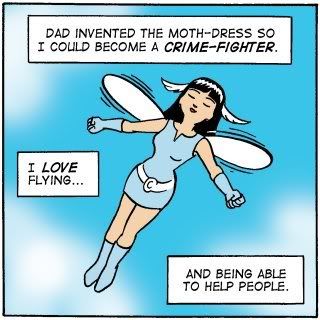

The new issue of Mania magazine #68 (Jan 2007) - featuring two 2 page Moth & Tanuki comics in colour - is out now! The two stories are an "Introduction" piece (about Blogging :)) and Sk8brd Tanuki.
It's fun introducing these characters all over again, to a completely new audience. I think, considering the younger age-group that the focus will tend to be more on Tanuki (than the Moth focus of the OzTaku black-and-white series). I've been pleasantly surprised by the popularity of these characters, but they bounce off each other nicely and they're capable of shifting between extreme humour, satire and pathos as needed.
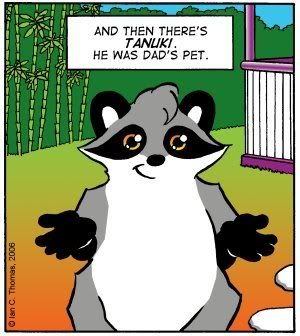
Time-wise, the Mania colour strips all take place after the entire run of the OzTaku stories, so Moth & Tanuki are completely settled in her father's house, and established in their work and relationships with other characters. There's more of an ensemble feel to the Mania episodes, with a regular and recurring cast.
During the period I was trying out for Mania (who had rejected a different series I offered early last year), I did some of these stories in a one page form. I might put one up here a bit later - the 2 page (better and more complete) version appears in this issue of Mania (#68). One of the later ones even went from one (packed) page, to a two page script, to a four page episode that I'm currently working on.
Mania #68 is available now from all good newsagents and supermarkets in Australia...

Labels: Mania, Moth and Tanuki
Friday, December 22, 2006
Rankin/Bass and Little Reindeer Christmas specials
Rankin/Bass Christmas films
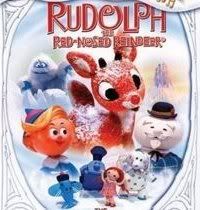 Last week, we were surprised to find DVDs of some old Rankin/Bass Christmas films for sale in the Supermarket. Apparently, these are seen regularly in the U.S., but they haven't been on TV (or available otherwise) in Australia for a long time. These old movies bring back memories for a lot of people around my age.
Last week, we were surprised to find DVDs of some old Rankin/Bass Christmas films for sale in the Supermarket. Apparently, these are seen regularly in the U.S., but they haven't been on TV (or available otherwise) in Australia for a long time. These old movies bring back memories for a lot of people around my age.
The stop-motion animation is, just as I remember, a joy to watch, and the scripts are quite witty and quirky - often given to the unexpected! My children are pretty much too old to be the intended audience, but seemed to enjoy these in any case.
Rudolph was the first one made (premiering in 1964), and it's already an accomplished effort. In one of the extras on the DVD Arthur Rankin tells of how Johnny Marks, who wrote the song, was a neighbour of his, and he actually wrote a number of other songs for the film. Burl Ives, as narrator Sam the Snowman, performs many of these. Interestingly one song, "We're a Couple of Misfits" was replaced for a period of time, but this release features the original cut. When I heard the album, Island of the Misfit Toys by prog band Timothy Pure a few years ago, I knew the title was familiar for some reason - it's from this film!
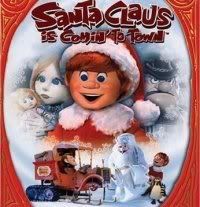 I'm inclined to think that Tim Burton drew much inspiration from these films as well, both in his interest in stop-motion animation and choosing it for A Nightmare Before Christmas, and the realization of grey people and cities contrasting with Santa's bright realm. Given that all stop-motion animators must be very aware of these films, the Penguin in Wallace & Gromit's The Wrong Trousers also owes a huge debt to Topper the Penguin from this film.
I'm inclined to think that Tim Burton drew much inspiration from these films as well, both in his interest in stop-motion animation and choosing it for A Nightmare Before Christmas, and the realization of grey people and cities contrasting with Santa's bright realm. Given that all stop-motion animators must be very aware of these films, the Penguin in Wallace & Gromit's The Wrong Trousers also owes a huge debt to Topper the Penguin from this film.
In story terms, Santa Claus is probably more successful than Rudolph, which is as it should be, with this coming a few years later. Santa is certainly a nicer character (he's pretty mean in Rudolph) and it's a great relief that a major baddie is converted without having to have his teeth pulled out.
Choosing to tell an etiological (explaining known elements) story, and one that wholly reimagines the origins of Santa, is a great concept! For one thing, the recognition and sense of being in on the jokes works really well for kids. Looking at the red-haired Kris Kringle character I can see why I liked this film as a kid - he looks a lot like me :).
Miss Jessica has to be about the most gorgeous animated puppet ever, though her weirdly psychedelic, cheesily animated solo song (where she lets her hair down) comes on a bit like a lost James Bond theme. All in all, I'm in awe of wooden/fabric puppet animation - all that swapping of face parts and moving figures with such basic inertia in a co-ordinated and endearing way is still remarkable.
Others in the series include The Little Drummer Boy, and Frosty the Snowman (done with line animation).
The Little Reindeer
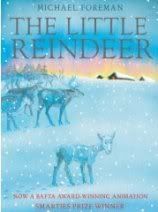 A new Christmas special on TV this year is a half-hour adaptation of Michael Foreman's fine watercolour picture-book, The Little Reindeer.
A new Christmas special on TV this year is a half-hour adaptation of Michael Foreman's fine watercolour picture-book, The Little Reindeer.
This book has been a staple classic in our house for some years, though it disappeared elsewhere. While this television adaptation is set in London (the scenes of Santa's sleigh flying over English landmarks recall Raymond Briggs' excellent Father Christmas books), the original book was set in New York. Our copy was a public library book discarded immediately after 9/11, as the Twin Towers feature prominently in a number of pictures. I haven't had a chance to see how this might have been redressed in the reissue (anyone?). In the film adaptation it was nice to see Foreman's team in a sense reclaim this imagery, with a scene of the boy photographing a jet airliner flying over a cityscape of tall buildings.
 The television adaptation retains the watercolour textures and exquisite colour choices of Michael Foreman's original illustrations, while preserving the tone of the story. Apart from the addition of a minor bullying subplot it is completely faithful. However, the story is told almost completely without words - just accompanying music and some narration (J. was irritated by some of the recurring musical themes used for characters :)). This one is a nice new addition to the somewhat diminishing roster of Christmas children's shows.
The television adaptation retains the watercolour textures and exquisite colour choices of Michael Foreman's original illustrations, while preserving the tone of the story. Apart from the addition of a minor bullying subplot it is completely faithful. However, the story is told almost completely without words - just accompanying music and some narration (J. was irritated by some of the recurring musical themes used for characters :)). This one is a nice new addition to the somewhat diminishing roster of Christmas children's shows.
 Last week, we were surprised to find DVDs of some old Rankin/Bass Christmas films for sale in the Supermarket. Apparently, these are seen regularly in the U.S., but they haven't been on TV (or available otherwise) in Australia for a long time. These old movies bring back memories for a lot of people around my age.
Last week, we were surprised to find DVDs of some old Rankin/Bass Christmas films for sale in the Supermarket. Apparently, these are seen regularly in the U.S., but they haven't been on TV (or available otherwise) in Australia for a long time. These old movies bring back memories for a lot of people around my age.The stop-motion animation is, just as I remember, a joy to watch, and the scripts are quite witty and quirky - often given to the unexpected! My children are pretty much too old to be the intended audience, but seemed to enjoy these in any case.
Rudolph was the first one made (premiering in 1964), and it's already an accomplished effort. In one of the extras on the DVD Arthur Rankin tells of how Johnny Marks, who wrote the song, was a neighbour of his, and he actually wrote a number of other songs for the film. Burl Ives, as narrator Sam the Snowman, performs many of these. Interestingly one song, "We're a Couple of Misfits" was replaced for a period of time, but this release features the original cut. When I heard the album, Island of the Misfit Toys by prog band Timothy Pure a few years ago, I knew the title was familiar for some reason - it's from this film!
 I'm inclined to think that Tim Burton drew much inspiration from these films as well, both in his interest in stop-motion animation and choosing it for A Nightmare Before Christmas, and the realization of grey people and cities contrasting with Santa's bright realm. Given that all stop-motion animators must be very aware of these films, the Penguin in Wallace & Gromit's The Wrong Trousers also owes a huge debt to Topper the Penguin from this film.
I'm inclined to think that Tim Burton drew much inspiration from these films as well, both in his interest in stop-motion animation and choosing it for A Nightmare Before Christmas, and the realization of grey people and cities contrasting with Santa's bright realm. Given that all stop-motion animators must be very aware of these films, the Penguin in Wallace & Gromit's The Wrong Trousers also owes a huge debt to Topper the Penguin from this film.In story terms, Santa Claus is probably more successful than Rudolph, which is as it should be, with this coming a few years later. Santa is certainly a nicer character (he's pretty mean in Rudolph) and it's a great relief that a major baddie is converted without having to have his teeth pulled out.
Choosing to tell an etiological (explaining known elements) story, and one that wholly reimagines the origins of Santa, is a great concept! For one thing, the recognition and sense of being in on the jokes works really well for kids. Looking at the red-haired Kris Kringle character I can see why I liked this film as a kid - he looks a lot like me :).
Miss Jessica has to be about the most gorgeous animated puppet ever, though her weirdly psychedelic, cheesily animated solo song (where she lets her hair down) comes on a bit like a lost James Bond theme. All in all, I'm in awe of wooden/fabric puppet animation - all that swapping of face parts and moving figures with such basic inertia in a co-ordinated and endearing way is still remarkable.
Others in the series include The Little Drummer Boy, and Frosty the Snowman (done with line animation).
The Little Reindeer
 A new Christmas special on TV this year is a half-hour adaptation of Michael Foreman's fine watercolour picture-book, The Little Reindeer.
A new Christmas special on TV this year is a half-hour adaptation of Michael Foreman's fine watercolour picture-book, The Little Reindeer. This book has been a staple classic in our house for some years, though it disappeared elsewhere. While this television adaptation is set in London (the scenes of Santa's sleigh flying over English landmarks recall Raymond Briggs' excellent Father Christmas books), the original book was set in New York. Our copy was a public library book discarded immediately after 9/11, as the Twin Towers feature prominently in a number of pictures. I haven't had a chance to see how this might have been redressed in the reissue (anyone?). In the film adaptation it was nice to see Foreman's team in a sense reclaim this imagery, with a scene of the boy photographing a jet airliner flying over a cityscape of tall buildings.
 The television adaptation retains the watercolour textures and exquisite colour choices of Michael Foreman's original illustrations, while preserving the tone of the story. Apart from the addition of a minor bullying subplot it is completely faithful. However, the story is told almost completely without words - just accompanying music and some narration (J. was irritated by some of the recurring musical themes used for characters :)). This one is a nice new addition to the somewhat diminishing roster of Christmas children's shows.
The television adaptation retains the watercolour textures and exquisite colour choices of Michael Foreman's original illustrations, while preserving the tone of the story. Apart from the addition of a minor bullying subplot it is completely faithful. However, the story is told almost completely without words - just accompanying music and some narration (J. was irritated by some of the recurring musical themes used for characters :)). This one is a nice new addition to the somewhat diminishing roster of Christmas children's shows.Labels: Rankin/Bass, Rudolph, The Little Reindeer
Monday, December 18, 2006
Recent bird album covers
This has been growing for a while. I decided to split the usual roundup of current/recent album covers using animals as iconic images, by putting birds into their own category. Actually, there turned out to be so many that they're not all here, so at least one might appear in the next lot. It's been a good year for birds in music, kicking off with Kate Bush's Aerial, featuring a clever soundscape as landscape cover, built out of a blackbird's song.
My usual principle for selecting these images is that the animal/bird has to be the featured icon, not just a minor accessory to a picture of the artist. I decided to relax that a bit this time, so the last three do include people (one even the artist herself).
(Click on pic for closeup - list and short reviews below)

Top rowPatricia Barber - Mythologies - jazz at the frontier, an inspired song cycle based on Ovid The Morning Birds - Lay - Melbourne trio, trip-hop, blues-roots featuring guitars and cello Lisa Germano - In the Maybe World - Musings on death from powerful singer/musician Bert Jansch - The Black Swan - timeless wistful acoustic magic from Scottish folk-singer
2nd RowThe Melvins - Houdini Live: a Live History of Gluttony and Lust - 12 years of Washington sludge remade live in studio with guests Erase Errata - Nightlife - A timely best yet from regrouped indie rock band of female musicians Andrew Morris - Valleys - second country/folk/rock album from Brisbane singer/songwriter The Red Eyes - Rudeworld - New album from huge 11-piece Australian dub reggae group
3rd RowLABJACD - Vote With Your Feet - Melbourne 9 piece with big sounding hiphop/salsa/jazz The Watson Twins - Southern Manners - acoustic rock featuring dreamy melodic harmonies from twin sisters Because of Ghosts - The Tomorrow We Were Promised Yesterday - evocative moody debut from Melbourne instrumental trio of brothers Joanna Newson - Ys- 5 songs, 55 minutes, a lush, ambitious journey
My usual principle for selecting these images is that the animal/bird has to be the featured icon, not just a minor accessory to a picture of the artist. I decided to relax that a bit this time, so the last three do include people (one even the artist herself).
(Click on pic for closeup - list and short reviews below)

Top row
2nd Row
3rd Row
Labels: Animal album covers, Bird album covers
Thursday, December 14, 2006
Business as usual
This morning I work up - thankfully early - to find that the my alarm hadn't gone off and the power was blacked out yet again. I got up and went up to the power box around the corner and this time, underneath the box, was a dead cockatoo with a large black hole in it. I rang TRUEnergy as usual to report it, but am getting really sick of this. Apart from the regular animal and bird deaths, we've lost a DVD player and one computer hard disk (replaced under warranty from the manufacturer). I wish they'd get a bit more excited about this problem.
Wednesday, December 06, 2006
Baiji extinct in 2006
As I sometimes write here reporting the discovery of new species, it's only fair that I mention some significant extinctions as they occur. I may be jumping the gun on this one, but sadly, I don't think so - I'd love to be wrong...
In The Age on the weekend, I was surprised to find a full page article on the baiji a favourite animal of mine.
I'd been reading the Baiji Org site (the source of the above picture) for a while, so I knew a major search for survivors was about to begin.
From the Age article:
"A team of the world's leading marine biologists is making a last-gasp search for the baiji, a dolphin that was revered as the goddess of Asia's mightiest river but is now probably the planet's most endangered mammal. In the 1950s, there were thousands of baiji in the Yangtze. By 1994, the number fell below 100. This year, there has only been one, unconfirmed, sighting."
About a week ago on the Baiji blog, Doli wrote:
... the Last Baiji:
"A lot of people outside China have probably never heard of the Baiji dolphin before. This is a pity because even though it is one of the rarest animals on earth, it is also one of the most interesting and beautiful. First of all, unlike most other Cetacean species, (Cetaceans being whales, dolphins and porpoises), it lives exclusively in a freshwater ecosystem, namely the Yangtze River."
As with so many areas of zoology, my introduction to the baiji was in Bernard Heuvelmans' cryptozoology book On the Track of Unknown Animals - he names the date of scientific discovery as 1918, but other sources state 1914 (though local Chinese fishermen were long familiar with them). Then I remember being amazed by photographs of this elusive and beautiful animal in a World of Wildlife encyclopaedia I collected week-by-week in my teens.
Many years later I was reminded about the baiji by the chapter, Blind Panic, in (the late) Douglas Adams and Mark Carwardine's Last Chance to See.
Adams writes of the baiji's perils: "constantly being mangled in ship's propellers, snared in fishermen's nets full of hooks, blinded, poisoned and deafened." On putting a microphone into the ever busy river, he wrote: "Instead of hearing the roar of each individual ship's propeller, what we heard was a sustained shrieking blast of pure white noise, in which nothing could be distinguished at all."
The book includes some good pictures of Qi Qi, the male baiji resident at Wuhan Institute of Hydrobiology from 1980 to July 14, 2002 (he was apparently found in Dongting Lake - where the 1914 one was found - severely injured by a fishing hook and nursed back to health using Chinese traditional medicine). Qi Qi was exceptional in surviving well in captivity. While captive breeding presented the only hope, it is sadly familiar - remembering the thylacine - to have the last known specimen of an incredibly ancient species die in captivity.
 For a good overall written account of what is known about the baiji, I recommend Lyall Watson's (author of Supernature) book, Whales of the World.
For a good overall written account of what is known about the baiji, I recommend Lyall Watson's (author of Supernature) book, Whales of the World.One resoundingly positive aspect of all the effort made to try to preserve the baiji is that the Yangtze finless porpoise - also critically endangered and down to a few hundred, may benefit.
It's highly likely that the baiji went extinct either this year or last year - with the Three Gorges Dam added to their woes, and all the former perils greatly increased, it does appear likely. Still, I really do hope to be wrong, though discovery of a remnant population is but a beginning in attempting to conserve this beautiful animal.
Recommended starting points:
Labels: Baiji, extinction, freshwater dolphins
